Yong tau foo is a Chinese cuisine that has become one of Malaysia’s most famous street foods. It is a Hakka Chinese food, and the word in Chinese 酿豆腐 means stuffed tofu.
This Chinese cuisine has evolved in Malaysia with its interpretation, including various vegetables besides tofu. They are either deep-fried, pan-fried, or served by boiling in soup stock and with a dipping sauce or curry.
Ampang is the place in Malaysia famous for the best yong tau foo.
You can find this comfort food in most food courts and coffee shops which have become a staple for breakfast and lunch. Some stores also change the recipe so that those who do not eat pork can also enjoy a bowl of yong tau foo.
Note: This post may contain affiliate links. Please read my privacy policy for more info. I may receive commissions for purchases made through links in this post. As an Amazon Associate, I earn from qualifying purchases.
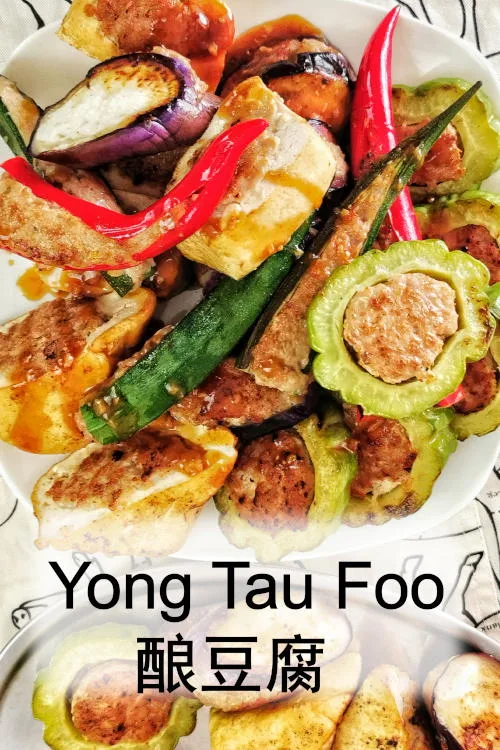
1. How to make the yong tau foo stuffing
This recipe is loosely based on the Hakka Yong Tau Foo recipe.
Most of the stuffings for yong tau foo (also spelled as yong tau fu) are made with minced pork, fish paste, or a combination. The most common type of fish meat in Malaysia is Spanish mackerel (Tenggiri Batang/马鲛鱼). I use another kind called Ikan Parang (Wolf Herring / 西刀鱼) in this recipe.
- Since we only need the fish meat, the easiest way is to fillet the fish, then use a metal spoon to scrape the fish meat from the skin. There will be bones attached, which you must carefully remove. After that, place the fish meat on a chopping board and mince it finely. Alternatively, ready-made fish paste for making fish balls and yong tau foo is sold in the wet market in Malaysia.
- Transfer the fish paste to a large mixing bowl.
- You also need some pork since most of the stuffing is a combination of fish and pork. Pork belly is best as it contains a fair share of fat. An easy way is to buy some minced meat with some fat from your butcher.
- The ratio of pork to fish varies, ranging from pure fish paste to pork only. I use 50% of fish and 50% pork in this recipe.
- Add the cornstarch, salt, light soy sauce, ground white pepper, and chopped garlic to the meat, and mix well.
- Minced garlic is necessary to counter the unwanted smell of fish meat.
- Now hold the meat with your clean hand, leave it up, and repeatedly throw it back into the bowl. This action is a classic technique to incorporate the meat with other ingredients and transform the texture of the meat paste to become more springy. Do this action repeatedly for 2-3 minutes, and you will notice the texture of the meat paste has become very pasty and sticky. When this happens, it is done.
Note:
- The fish paste is ideal for making fish balls and fish cake (both are similar but different in shape).
- The stuffing can be made in advance, divided into small portions, and kept frozen.
- There are other variations you can explore. One way I would want to try next time is to add a small amount of salted fish into the stuffing.
2. How to stuff the tofu and vegetables
Besides stuffed tofu, bitter gourd, lady’s fingers, eggplants, beancurd skin, tofu puffs, and chilies are other everyday items included in the family of yong tau foo.
- Remove the seeds and pith of the red chilies.
- Similarly, do the same for the lady’s fingers.
- As for the eggplants, cut into half an inch thick slices, then make an incision at the middle of each slice just shy of cutting it through.
- Cut the bitter gourd crosswise into 1cm rings, then remove the seeds with a metal spoon.
- As for the tofu, cut each block into half, then make a hole by using a metal spoon to remove part of the tofu at the center. This way will create a space to stuff the filling.
- Cut the Chinese eggplant to about 1.5cm thick.
- Pick up the meat paste with a small metal spoon or butter knife and press it into the cavity of the tofu and vegetables. Try to press firmly into the opening to prevent it from falling off while cooking.
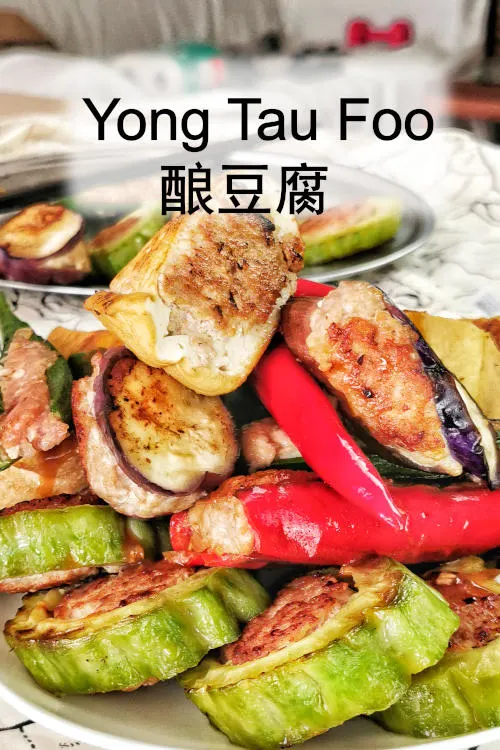
3. How to cook the yong tau foo
You can either deep-fry, pan-fry or boil the yong tau foo in water. Pan-fry is my personal favorite because it requires less oil than deep-frying.
- Place tofu and stuffed vegetables into the pan, with the meat side down.
- Shallow fry the young tau foo until the meat side turns slightly charred, then turn over and continue to pan-fry the other side.
- I would suggest covering the pan with the lid for at least one minute during the cooking process, especially for those large yong tau foo pieces. This step ensures the meat paste is thoroughly cooked when both sides have turned golden.
- Remove the fried yong tau foo and place it on a kitchen towel to remove the excess oil.
Note: You can keep the raw yong tau foo in the chiller for three days if you are not cooking them immediately.
4. How to make the yong tau foo sauce
Fried yong tau foo is best served with a sauce drizzled on top. One of the most popular sauces is called sweet sauce (甜酱), which is also famous for serving with the local chee cheong fun 肠粉. Other variations are the fermented black bean paste (豆豉酱) and fermented yellow bean paste (豆醬/taucu), which is made with soybeans.
I made the sauce with fermented yellow bean paste.
Here are the steps:
- Heat some peanut oil in a pan to medium.
- Add the chopped garlic and saute until aromatic.
- Add half a cup of water, followed by light soy sauce, oyster sauce, taucu, sugar, and ground white pepper.
- Thicken the sauce with a cornstarch slurry to form a thick gravy.
5. How to serve
Drizzle the sauce above on the fried pieces, sprinkle some chopped spring onions on top, and serve with dried noodles or as a single standalone dish.
Besides the dry version, you can boil them in the soup stock to serve with flat rice noodles (kway teow) or rice vermicelli.
Note:
- Use fermented black bean to replace taucu if you want to make the black bean sauce.
- The fermented black beans and taucu are salty; hence there is no need to add salt while cooking.
- You can explore adding Vietnamese fish sauce, Hoisin sauce, and sesame oil to change the taste.
Related recipes
You likely want to try other Malaysian street food if you like Yong Tau Foo. Here are my picks:
- Cucur udang is the Malaysian version of prawn fritters and has a crunchy exterior when fresh from the wok, with a soft interior filled with various vegetables.
- Char Kuey Teow of Penang has ranked 14th on the World Street Food Top 50 list at Manila’s World Street Food Congress 2017. Try this home version if you are not able to travel to Penang.
- Nasi Lemak is the breakfast and lunch staple in Malaysia. This drool-worthy, gluttonous gem is wrapped in paper and banana leaves, which has become the quintessential meal for the locals.
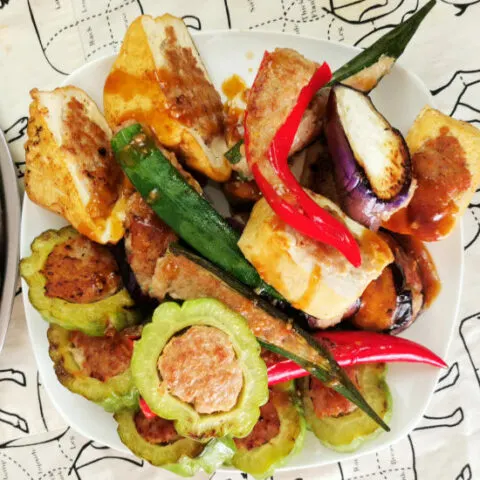
Yong Tau Foo- How to make this mouthwatering street food at home
Yong tau foo is a Chinese cuisine that has become one of Malaysia's most famous street foods. It is a Hakka Chinese food, and the word in Chinese 酿豆腐 means stuffed tofu.
This Chinese cuisine has evolved in Malaysia with its interpretation, including various vegetables besides tofu. They are either deep-fried, pan-fried, or served by boiling in soup stock and with a dipping sauce or curry.
Ingredients
Ingredients A (stuffing):
- 350g minced pork (or substitute fully with fish paste)
- 350g fish paste
- 1 tbsp cornstarch
- 1 tsp salt
- 2 tbsp light soy sauce
- 1/4 tsp ground white pepper
- 6 clove garlic
Ingredients B (tofu and vegetables):
- 4 red chilies
- 1/2 Chinese eggplants
- 5 ladyfingers
- 4 firm tofu
- 1/2 bitter gourd
Ingredients C (sauce):
- 2 tbsp peanut oil
- 1 tbsp chopped garlic
- 1 tbsp light soy sauce
- 4 tbsp water
- 1 tbsp taucu
- 1 tbsp sugar
- 1/4 tsp ground white pepper
- 2 tsp cornstarch, to make a slurry with water
Instructions
The stuffing
- Mix the fish paste, minced pork, cornstarch, salt, light soy sauce, ground white pepper, and chopped garlic to the meat, and mix well.
- Hold the meat with your clean hand, leave it up, and repeatedly throw it back into the bowl. Do this action repeatedly for 2-3 minutes, and you will notice the texture of the meat paste has become very pasty and sticky.
The tofu and vegetables
- Remove the seeds and pith of the red chilies and lady's fingers.
- Cut the eggplants into half an inch thick slices, then make an incision at the middle of each slice just shy of cutting it through.
- Cut the bitter gourd crosswise into 1cm rings, then remove the seeds with a metal spoon.
- As for the tofu, cut each block into half, then make a hole by using a metal spoon to remove part of the tofu at the center.
- Cut the Chinese eggplant to about 1.5cm thick.
- Press the stuffing into the cavity of the tofu and vegetables.
Pan-fry the yong tau foo
- Pan-fry the tofu and stuffed vegetables into the pan, with the meat side down.
- When the meat side turns slightly charred, turn over and continue to pan-fry the other side.
- Cover the pan with the lid for one minute to ensure the meat paste is thoroughly cooked.
- Remove the fried yong tau foo and place it on a kitchen towel.
Make the sauce
- Heat some peanuts in a pan to medium.
- Add the chopped garlic and saute until aromatic.
- Add half a cup of water, followed by light soy sauce, oyster sauce, taucu, sugar, and ground white pepper.
- Thicken the sauce with a cornstarch slurry to form a thick gravy.
Recommended Products
As an Amazon Associate and member of other affiliate programs, I earn from qualifying purchases.
Nutrition Information:
Yield: 25 Serving Size: 1Amount Per Serving: Calories: 143Total Fat: 7gSaturated Fat: 2gTrans Fat: 0gUnsaturated Fat: 5gCholesterol: 25mgSodium: 247mgCarbohydrates: 5gFiber: 1gSugar: 2gProtein: 15g
This data was provided and calculated by Nutritionix on 4/4/2022

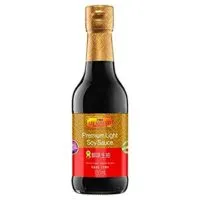

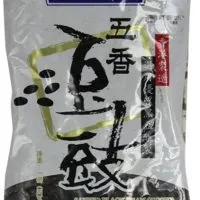
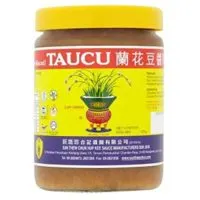
William Saw
Friday 19th of January 2024
I love Yong tau foo, thank you for the recipes.
Marie
Saturday 9th of April 2022
What do you mean by "ladyfingers" what type of vegetable is it?
KP Kwan
Sunday 10th of April 2022
Okra is called ladyfingers where I live.
KP Kwan
Saturday 9th of April 2022
Hi, this is KP Kwan. I am happy to see you in this comment area, as you have read through my recipe. I am glad to reply to any questions and comments as soon as possible.